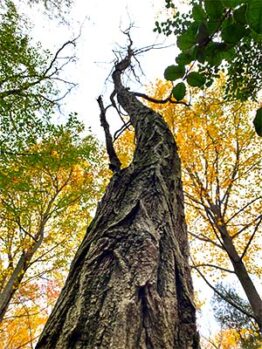Black Locust
Researched by Christian Chapman
 Species: Robinia pseudoacacia
Species: Robinia pseudoacacia
Common name: Black Locust, Pea Flower Locust
Family: Robinia
Clade: Deciduous Angiosperm (Flowering)
Coordinates: 39.71127375, -75.12443844
A tag using this number is placed near the tree.
British colonists discovered a black locust, Robinia pseudoacacia, in 1607 at Jamestown, Virginia. The Robinia genus is part of the Fabaceae family, more commonly known as the “legume or pea/bean” family, which includes Honey Locust (Gleditsia triacanthos) and Eastern Redbud (Cercis canadensis). Black locust trees originate from southern Appalachia and are known for their resilience, which is why the early colonists used its wood for construction. The dark bark of this tree has a rough texture that makes it easy to spot when looking for it in wooded areas. It is known for having some of the strongest and hardest wood among native North American trees, making it useful for construction, boats, and fencing.
Native Americans used black locust for bows and other purposes. Despite it being native, the tree is also considered invasive because it produces “suckers,” or clones of itself, from roots that are difficult to remove. Read More
Campus Species Map
Researcher’s Biography

Christian Chapman
Christian Chapman earned a Bachelor of Science in Biology in 2024.
Suggested Citation:
Chapman, Christian. (2022, Dec). Black Locust. Rowan University Arboretum. https://arboretum.rowan.edu/trees/black-locust/
Questions to Explore
- Why do black locust trees get used by animals as shelter?
- What plant species adapted to the aggressive growth of the Robinia pseudoacacia, and why?
- Is the black locust a highly adaptable species?
- What is the genetic significance of the Robinia pseudoacacia having dark, rigid bark?
- Is the wood of these trees preferred over other tree species by organisms such as beavers and woodpeckers?
References
(2018, February 6). Yale University. Black Locust | Yale Nature Walk. | Link
Garden, C. B. (n.d.). Black Locust. Budburst. | Link
Huntley, J. C. (n.d.). Black Locust. Robinia Pseudoacacia L. | Link
Keresztesi, B. (1988). Black Locust: The Tree of Agriculture. Outlook on Agriculture, 17(2), 77-85.
| Link
Nasir, H., Iqbal, Z., Hiradate, S. et al. Allelopathic Potential of Robinia pseudo-acacia L.. J Chemical Ecology 31, 2179–2192 (2005). | Link
Nicolescu, V.-N., Mason, W. L., Vor, T., Bastien, J.-C., Brus, R., Cvjetkovic, B., Porta, N. L., Lavnyy, V., Petkova, K., Mohren, G. M. J., Monteverdi, M. C., & Musch, B. (2020). Ecology, growth and management of black locust (Robinia pseudoacacia L.), a non-native species integrated into European forests. Journal of Forestry Research. | Link
Tian, F., & Mclaughlin, J. L. (2011). Bioactive flavonoids from the black locust tree, Robinia pseudoacacia. | Link












